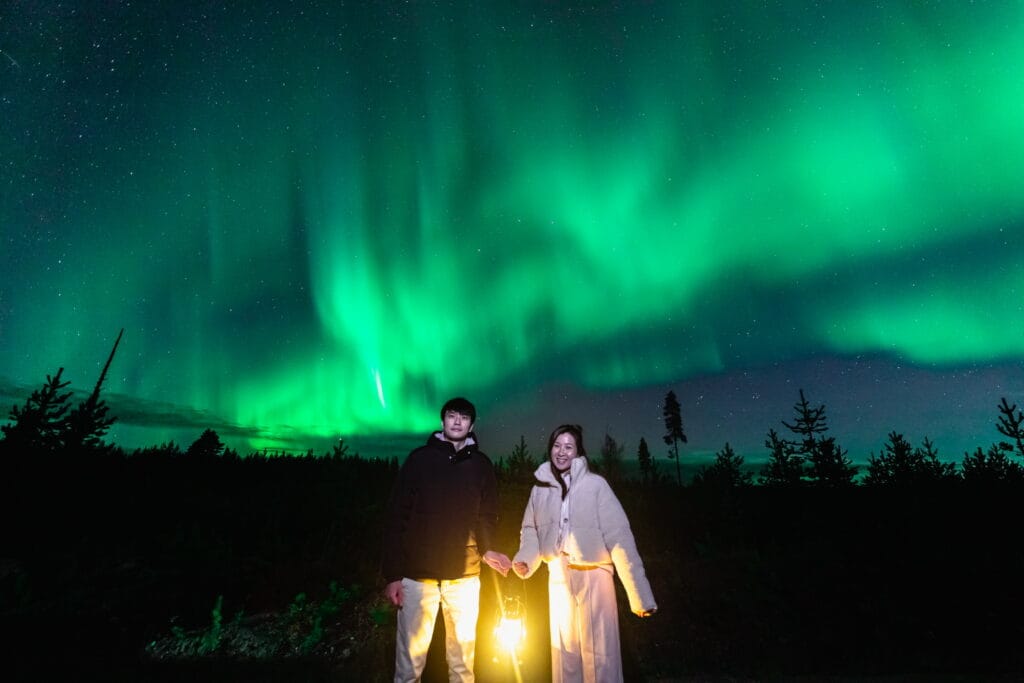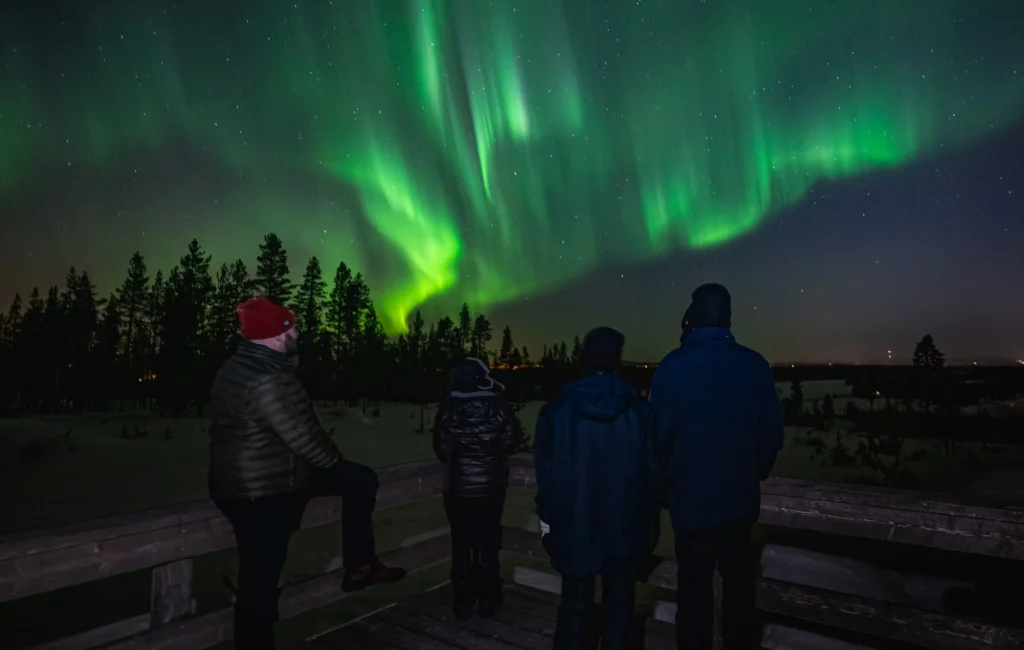Yes, you can absolutely see the Northern Lights in Rovaniemi! The best time to see them is from late August to early April when the nights are dark. For the highest chances, you need a clear sky and to get away from the city lights. Peak viewing months are often September-October and February-March, typically between 9 PM and 2 AM.
- So, Can You Really See the Northern Lights in Rovaniemi?
- The Three Ingredients for a Sighting: Darkness, Clear Skies, and Solar Activity
- Managing Expectations: The Reality of an Aurora Hunt Near the Arctic Circle
- Your Aurora Chasing Toolkit: Apps, Forecasts, and Why Mobility is Key
- Defining Success: It’s More Than Just a Photograph
So, Can You Really See the Northern Lights in Rovaniemi?
Let’s get straight to it. You’re dreaming of seeing the aurora dance, and you’re wondering if Rovaniemi is the place. The answer is a big, resounding YES! Being right on the Arctic Circle, Rovaniemi is perfectly placed for the cosmic show.
But here’s the secret: the Northern Lights are a natural phenomenon, a magical chase rather than a guaranteed spectacle. Success depends on two key things: solar activity and a clear, dark sky. What we can promise is putting you in the best possible seat in the house, far from the city glow, where the magic can truly happen.
The Three Ingredients for a Sighting: Darkness, Clear Skies, and Solar Activity
Think of hunting for the Northern Lights in Rovaniemi like baking a cake. You need the right ingredients for it to work. Miss one, and the result just isn’t the same. Luckily, the recipe is pretty simple, even if one ingredient is a bit of a wild card.
Ingredient #1: Total Darkness
This is the easy one. The Northern Lights are often quite faint, and any competing light will wash them out completely. This means two things for your trip:
- The right time of year: You need dark nights, which is why the aurora season runs from late August to early April. In summer, the Midnight Sun means it never gets dark enough.
- The right location: You have to escape the city. Even the glow from Rovaniemi can dim the show. That’s why we head out into the wilderness, to a place where the only lights are the stars and, hopefully, the aurora.
Ingredient #2: Clear Skies
This is the aurora hunter’s biggest hurdle. You could have the most spectacular solar storm happening in space, but if a thick blanket of clouds is covering Lapland, you won’t see a thing. It’s like trying to watch a movie with a curtain pulled down in front of the screen.
This is where being on a guided chase really pays off. Our guides at Book Lapland are experts at reading local weather patterns and are willing to drive to find a break in the clouds, dramatically increasing your chances.
Ingredient #3: Solar Activity (The Wild Card)
This is the magic ingredient. The lights are caused by particles from the sun hitting our atmosphere. Sometimes the sun sends a gentle breeze, creating a soft green glow. Other times, it unleashes a solar storm, creating a wild, colourful dance that fills the entire sky.
This is the one part we can’t control. There are forecasts, of course, but they are just that—forecasts. The truth is, the aurora can surprise us, appearing when it’s not “supposed to” and hiding when the predictions are high. That unpredictability is what makes seeing it so incredibly special. It’s a genuine gift from the cosmos.

Managing Expectations: The Reality of an Aurora Hunt Near the Arctic Circle
Okay, let’s have an honest chat, friend to friend. We see those mind-blowing photos online and think the sky will erupt in a neon rainbow the second we step outside. Sometimes, it does! But seeing the Nordlichter in Rovaniemi is a hunt, a chase, a game of cosmic hide-and-seek. It’s important to know what you’re really looking for.
What the Eye Sees vs. What the Camera Captures
Here’s a little secret: our eyes and cameras see the aurora differently. Cameras can take in light for several seconds, building up colour and intensity. This is how you get those super-vibrant, out-of-this-world photos. To your naked eye, the show might begin as a faint, milky-white or greyish arc across the sky, almost like a strange cloud. Is that it? you might wonder. And then, as your eyes adjust and the activity strengthens, the greens begin to appear. On a truly magnificent night, you’ll see those colours and the dancing movement with perfect clarity. But knowing that it often starts subtly is key!
Patience is Your Warmest Coat
The aurora doesn’t run on a schedule. It can appear in a sudden, breathtaking burst for just five minutes, or it can hang in the sky and ripple gently for hours. There’s no way to know. This is why the experience we create is so important. While we wait for the main event, we’re not just standing in the cold. We’re gathered around a crackling fire, sipping hot berry juice, sharing stories, and soaking in the profound silence of the arctic night. The wait itself becomes a cherished memory.
It’s About the Chase, Not Just the Prize
This is the most important thing to remember. A trip to Lapland is about the whole adventure. It’s about feeling the crisp, clean air on your face, seeing more stars than you thought possible, and hearing the crunch of snow under your boots. The Northern Lights are the ultimate goal of the hunt, but the thrill is in the chase itself. If the sky decides to put on its magical show for you, it’s the most incredible, unforgettable bonus to an already amazing journey.
Your Aurora Chasing Toolkit: Apps, Forecasts, and Why Mobility is Key
While the aurora follows its own mystical rhythm, you’re not going into the chase blind! We have some fantastic modern tools that can give us a peek behind the cosmic curtain and help us be in the right place at the right time. Think of it as being a smart hunter, using every clue you can find.
Keeping an Eye on the Space Weather: Aurora Apps
Yes, there’s an app for that! Several, in fact. These apps are your window into what’s happening in space right now. They track things like solar wind speed and, most famously, the KP-index.
What’s a KP-index? Think of it as a simple power-level for the aurora, on a scale from 0 to 9. For seeing the Northern Lights in Rovaniemi, here’s a quick guide:
- KP 0-1: Things are very quiet.
- KP 2-3: This is a good sign! A solid chance of seeing a nice glow or a gentle dance directly overhead.
- KP 4+: Get your camera ready! This indicates a strong storm, and the chances for a spectacular, colourful show are high.
A couple of popular apps to check out are “My Aurora Forecast & Alerts” and “Aurora Now – Northern Lights”. But remember, these are forecasts, not promises. The sky can surprise us!
The Real Boss: The Weather Forecast
You can have a gigantic solar storm raging (a KP 7!), but if a thick layer of clouds is sitting over Rovaniemi, you won’t see a thing. This makes the weather forecast even more important than the aurora forecast. We look for clear patches in the sky—that’s our window to the show.
Mobility: Your Secret Weapon for a Successful Hunt
And this brings us to the most critical part of the toolkit: the ability to move. The weather in Lapland can be incredibly local. It might be cloudy over your hotel, but just a 20-minute drive away, the sky could be crystal clear.
This is the real magic of a guided chase. Staying in one spot is a gamble. Being mobile is a strategy. We use all the forecasts to see where the best chances are, and then we go there. Chasing down a break in the clouds is often the difference between going home with just a story about the cold and going home with a memory that will warm you for a lifetime.

Defining Success: It’s More Than Just a Photograph
So, you’ve seen the jaw-dropping pictures online. The ones with electric green ribbons twisting over a snowy landscape. It’s easy to think that success on a Northern Lights trip in Rovaniemi is measured by whether you capture that exact image. But let’s redefine success, shall we?
The Feeling You Can’t Capture
A photograph can’t capture the profound, absolute silence of the arctic wilderness. It can’t convey the feeling of the crisp, clean air on your cheeks or the sight of your breath puffing in the beam of a headlamp. It can’t show the sheer number of stars that explode into view once you’re away from the city—a sight that is, by itself, completely breathtaking.
Success is feeling small, in the best possible way, under a vast, endless sky. It’s a moment of pure awe and connection with nature that stays with you long after you’ve gone home.
The Warmth of the Shared Moment
Imagine this: you’re huddled around a crackling campfire, the flames casting a warm glow. You’re sharing stories and laughing with your family or new friends, sipping on hot berry juice that warms you from the inside out. You’re listening to a local guide tell tales of life in Lapland.
That right there? That’s success. It’s the cosy, happy, unforgettable moments you create while you wait for the sky to perform. The chase for the Nordlichter in Rovaniemi is a collective adventure, a shared experience of anticipation and wonder.
The Grand Finale is a Gift
Think of the entire evening—the journey into the dark forest, the campfire, the stars, the silence—as the main event. And if the aurora decides to appear? That’s the spectacular, magical, once-in-a-lifetime encore. It’s a gift from the cosmos, not an item on a checklist.
True success is the whole story you get to tell. The one about the adventure into the arctic night, the warmth of the fire, and the incredible moment you looked up and saw the sky begin to dance.
The Best Place to See the Northern Lights in Rovaniemi
So, where exactly is the best place to see the Northern Lights in Rovaniemi? The short answer: anywhere that’s dark, open, and far from the city lights. But let’s make it practical.
Option 1: Head Into the Wilderness
This is hands-down the most reliable way. Just a short drive from the city, you’ll find wide-open forests, frozen lakes, and silent fells where the glow of Rovaniemi disappears completely. These spots give you an unobstructed view of the sky and no competing light pollution—exactly what you need for a successful aurora hunt. Local guides know these secret places best and often change locations depending on weather conditions.
Option 2: Ounasvaara Hill
If you want something closer to town, Ounasvaara Hill is your go-to. It’s just a few minutes from the city center, and while not completely free from light pollution, it’s elevated and offers big sky views. On a clear, active night, it can deliver a spectacular show without venturing too far.
Option 3: Frozen Rivers and Lakes
In winter, the frozen rivers and lakes around Rovaniemi turn into natural viewing platforms. Imagine standing on a vast, glittering surface of snow and ice, with the aurora reflected on the frozen water—it’s breathtaking. Just make sure the ice is safe before venturing out.
Option 4: Aurora Glass Igloos and Cabins
If you’d like to chase the Northern Lights without leaving your bed, then a glass igloo or Aurora cabin is the dream option. These specially designed accommodations sit away from the city glow and give you a panoramic sky view. You can fall asleep under the stars and (with a bit of luck) wake up to the sky dancing above you.
The Real Secret
No matter where you are, the “best” place isn’t a single pin on the map—it’s the spot where the sky is clear on the night you’re chasing. The most experienced aurora hunters in Rovaniemi know this, which is why they stay flexible and mobile. Sometimes, driving just 20–30 minutes outside the city can turn a cloudy disappointment into an unforgettable memory.
How Aurora Forecasts and Guides Boost Your Chances
Even in the right location and season, the Northern Lights are unpredictable. Understanding forecasts helps—but having a professional guide makes all the difference.
Die KP index measures geomagnetic activity from 0–9, showing the potential strength of the aurora. Low KP nights produce faint glows, while high KP nights can create vibrant, overhead displays. Clouds and local weather are just as important: clear, cold nights make the aurora visible, while overcast skies can hide even the strongest activity.
This is where expert guides come in. They read local weather and aurora forecasts in real time and move the group to the clearest spots, maximizing your chance of seeing the northern lights. They also know how to spot subtle auroras early and share tips on observing and photographing them.
By combining forecasts, local knowledge, and mobility, guided tours turn the Northern Lights chase from a guessing game into a highly rewarding Arctic adventure.


